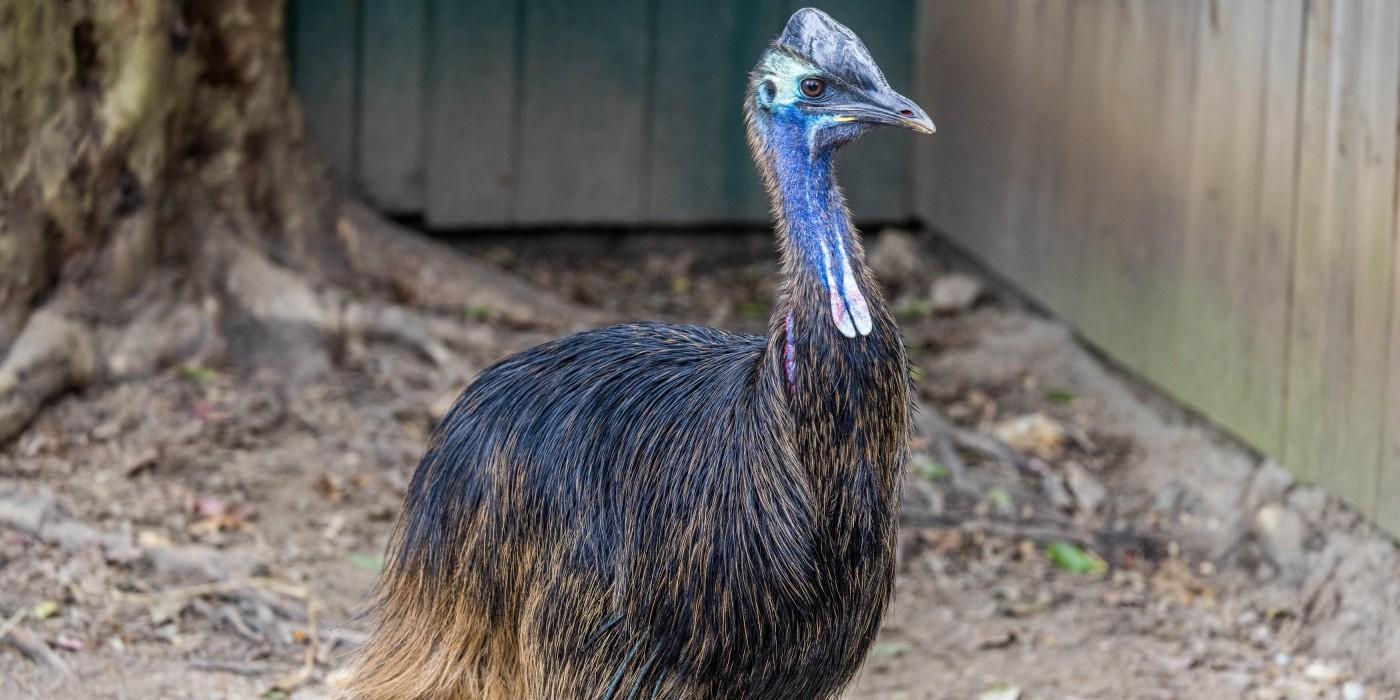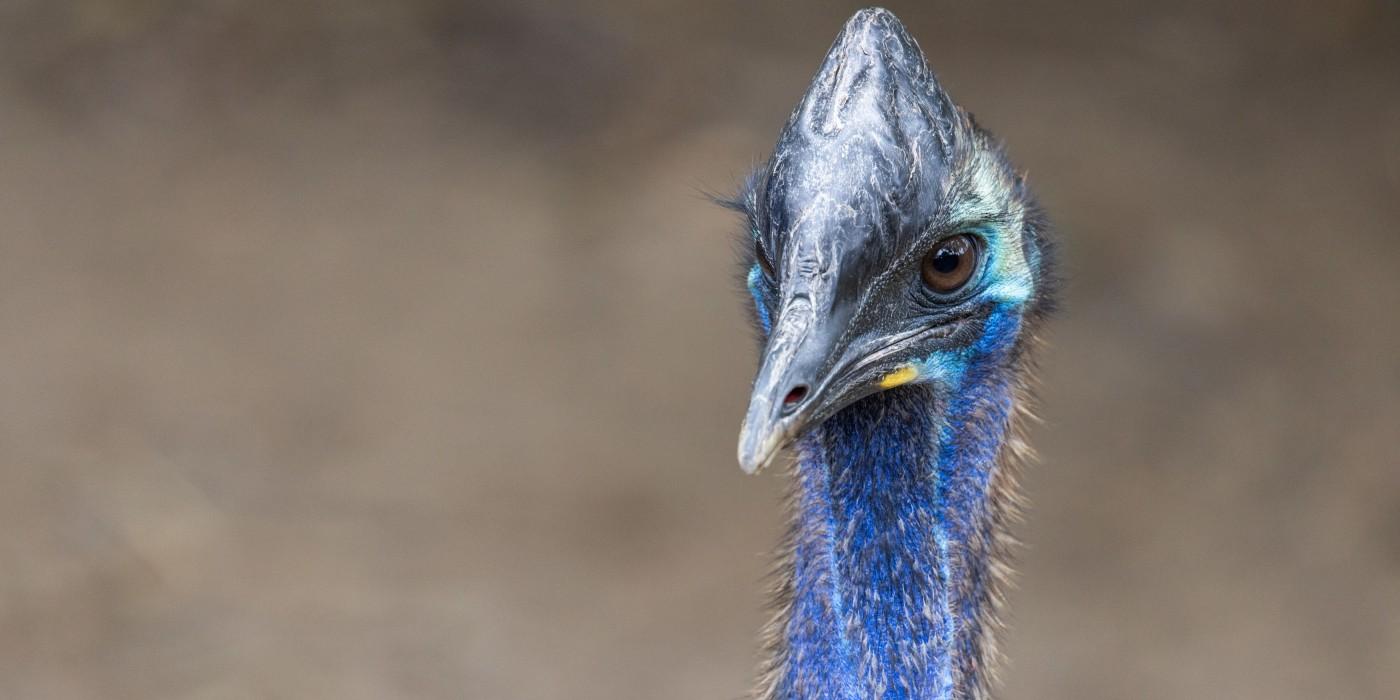Physical Description
Their large, black-feathered body, the casque on the top of their head, their bright blue necks with two hanging red wattles, and their razor-sharp inner toes make them look something like a cross between a turkey and a dinosaur.
One of the cassowary’s most unique and dinosaur-like features is the casque atop its head. It is a hollow, pointed structure made of keratin, the same substance as our hair and nails. The purpose of the casque eluded scientists for years, but recent studies suggest that it serves as a thermal window that lets heat escape from their bodies—like humans sweating or dogs panting.
When hatchlings are born, they are covered in soft, tan-colored plumage striped with dark brown. Immature cassowaries have sandy brown feathers, which turn glossy black as they reach maturity. Hatchlings are born without casques but develop them over their lives.
Size
Cassowaries are the third largest bird in the world, after ostriches and emus. Females are slightly larger than males and can reach up to 175 pounds (80 kilograms), while male cassowaries typically weigh about 121 pounds (55 kilograms). They can grow to be 5.5 feet tall (170 centimeters).
Native Habitat
They can be found in coastal lowland rainforests and grasslands. They are native to New Guinea and northern Queensland, Australia.
Lifespan
In the wild, they live for 18-20 years. In human care, cassowaries can live up to 40 years.
Communication
Intelligent birds, cassowaries have a wide repertoire of deep growls and rumbling sounds. During the breeding season, males communicate with potential mates by letting out low-frequency infrasound bellows, which are just at the limit of a human’s hearing range.
Food/Eating Habits
Despite their fearsome-looking appearance, cassowaries mostly eat fruits. However, they will sometimes eat small animals if the opportunity arises.
By eating fruits and dispersing the seeds through their droppings, cassowaries play a vital role in their native ecosystems. In fact, there are hundreds of species of plants that can only germinate after being passed through a cassowary’s digestive system.
At the Smithsonian’s National Zoo and Conservation Biology Institute, cassowaries are fed a daily assortment of grapes, tomatoes, squash, papaya, bananas, apples, sweet potatoes and carrots.
Social Structure
Southern cassowaries tend to live alone, only coming together to breed. Like many members of the ratite family of birds, cassowary chicks are looked after by their fathers until they are ready to live on their own.
Reproduction and Development
The timing of their breeding season can vary, but generally takes place in the winter months of the southern hemisphere (from April to November.)
Males build large, thick, oval-shaped nests out of grasses and sticks on the forest floor, usually hidden among dense plants. Females will lay between three to five dark green-colored eggs per clutch. Females are not monogamous, and their nests may contain eggs fathered by several different birds.
Males are the sole caregivers, incubating the eggs by themselves and raising the chicks, which hatch after about two months. Although the chicks are ready to leave the nest and walk around just a few hours after hatching, they need about nine months of parental care until they are ready to strike out on their own.
Conservation Efforts
Although the IUCN Red List of Threatened Species designates southern cassowaries as Least Concern, their population is decreasing in many parts of their range. Fewer than 1,500 of these birds survive in Australia. Their survival is threatened by habitat fragmentation, which creates genetic bottlenecks that reduce long-term genetic diversity and population stability. Additional threats include deforestation, car strikes, poaching and predation by dogs and feral pigs.
Help this Species
Reduce, reuse and recycle — in that order! Cut back on single-use goods, and find creative ways to reuse products at the end of their life cycle. Choose recycling over trash when possible.
Practice ecotourism by being an advocate for the environment when you’re on vacation. During your travels, support, visit or volunteer with organizations that protect wildlife. Shop smart too! Avoid buying products made from animals, which could support poaching and the illegal wildlife trade.
Consider going meat-free one day each week to help reduce the demand on the livestock industry and decrease your carbon footprint!
Are you a student? Did you love what you learned about this animal? Make it the topic of your next school project, or start a conservation club at your school. You'll learn even more and share the importance of saving species with classmates and teachers, too.
Less is more. Cut down on the demand for resources by consuming less. Buy only what you need, and look for pre-owned or repurposed items before purchasing something brand new.
Smithsonian's National Zoo and Conservation Biology Institute. (n.d.). Southern cassowary. Retrieved January 6, 2026, from https://nationalzoo.si.edu/animals/southern-cassowary
Animal News




